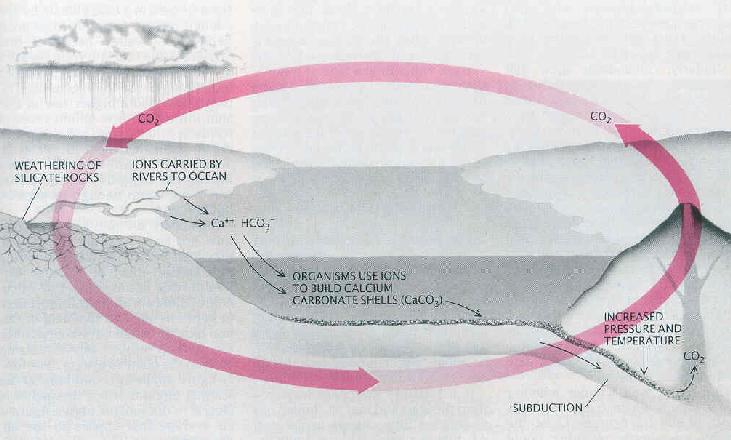The Goldilocks Problem
Remember the equilibrium temperature of a planet is linked
to its distance from the Sun (D):

And remember that the Earth's atmosphere and biosphere
is very sensitive to temperature -- a few degrees makes a lot of difference!
So if the Earth was a bit closer or a bit further from
the Sun, we might have radically different (inhospitable) conditions.
-
Too close: oceans boil
away, greenhouse effect kicks in. Hot, dry like Venus.
-
Too far: temperatures
drop, rapid glaciation.
-
The Goldilocks problem:
early calculations indicated that the "habitable zone" in the solar system
was 0.95 < D < 1.01 AU. Why would this
make you uncomfortable?
It gets worse: the sun has been increasing in luminosity
over time. Early in the Earth's history (several billion years ago), the
Sun had only 70% of its current luminosity. But liquid oceans have existed
on Earth for nearly 4 billion years. Why?
The Earth's temperature is regulated both by solar input
and by the greenhouse effect. If the solar input has changed over time,
the
greenhouse effect must have counterbalanced it to very good regularity.
How would that happen?
The Carbonate-Silicate Cycle
(also known as the Urey
Reaction)
-
Liquid water (rainfall) acts to "wash"
CO2 out of the atmosphere in the form of carbonic
acid:
CO2 (gas) + H2O (liquid)
--> H2CO3 (carbonic acid)
-
The carbonic acid weathers the rocks
on the Earth's surface, releasing ions of calcium
(Ca++) and bicarbonate (HCO-3)
into the oceans.
-
These combine into calcium carbonate
(CaCO3) on the sea floor either through
-
formation of carbonate rocks
-
living organisms making carbonate shells
-
The calcium carbonate is eventually subducted
down into the Earth (via plate tectonics), where high
temps and pressures convert it back to CO2
gas.
-
CO2 gas gets outgassed
from volcanos back into the atmosphere.
 In order to regulate the temperature to such high stability,
the carbonate-silicate cycle must be self-regulating.
That is, it must act to increase the greenhouse effect if the temperature
drops, and it must decrease the greenhouse effect if temperature rises.
In order to regulate the temperature to such high stability,
the carbonate-silicate cycle must be self-regulating.
That is, it must act to increase the greenhouse effect if the temperature
drops, and it must decrease the greenhouse effect if temperature rises.
-
Question: How would the cycle
change if temperatures rose significantly?
-
Question: How would the cycle
change if temperatures dropped significantly?
So let's presume that Venus, Earth, and Mars all started
out roughly with roughly similar compositions when they formed. Why
did the carbonate-silicate cycle make Earth "just right" while Venus and
Mars became so unfriendly?


